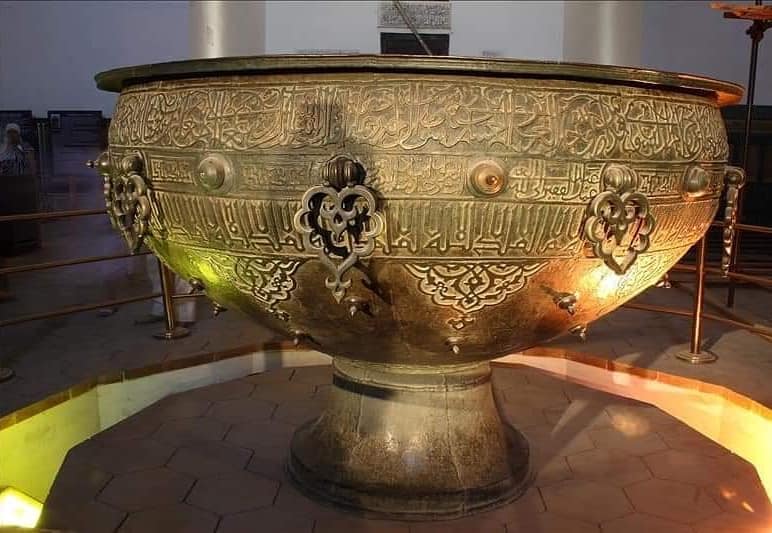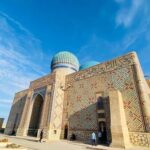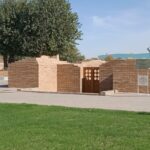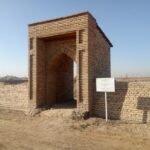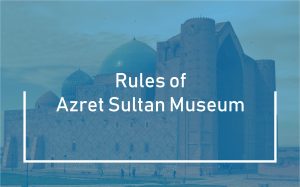The variety of types and forms of decorative-applied art stored in the mausoleum of Khoja Akhmet Yassawi (khanaka) has been raising the reputation of the Muslim region since time immemorial in the form of a museum. The exterior and interior decoration of the entire building are museum objects, and the historical value of these objects as individual artistic and decorative objects is enormous. The most notable, without a doubt, is the large bronze Taikazan, located in the center of the central and largest boiler room of the architectural complex.
Before proceeding to describe the place of the Taikazan in the teachings of the tasauf, it may be worth briefly outlining the general Sufi doctrine and the founder of the Turkic Sufi branch of Khoja Akhmet Yassawi and his tariqat.
The main purpose of tasawwuf is to combat the spiritual deficiencies (lust) hidden within the individual. Adherents of the doctrine of tasawwuf were called Sufis or dervishes. The Sufi doctrine was considered a mystical-ascetic trend in Islam. Sufism spread widely in Central Asia in the ninth and tenth centuries. Schools of separate Sufi movements gradually formed, to be followed by Sufi fraternities (tarikat). These fraternities were headed by preceptors. Such preceptors were known in Arabic as sheikh, in Persian as preceptor, and among Turkic-speaking peoples on a par with the above-mentioned names as ishan, ata. The most widespread Sufi tariqats in Central Asia were the Yaasawiyya, Kubrawiyya, and Naqshbandiyya tariqats. The Yasawiyya tariqat was widespread mainly among the nomadic Turks north of the banks of the Syr Darya.
Azret-Sultan Khoja Akhmet Yassawi (1093-1166) was a famous head of the Turkic Sufi branch, a thinker, mystic poet, and religious preacher. Khoja Akhmet Yassawi was born in 1093 in Sayram (Isfidzhab), according to other sources in 1103, 1036, 1041, and died in 1166 in Yassy (Turkestan). Khoja Akhmet Yassawi received elementary education by his father Ibrahim sheikh. He received further education and upbringing from Baha ad-Din Ispijabi, a scholar of the famous Hanafi sect. After that he visited the famous Arystan Baba of Otrar. Khoja Akhmet Yassawi received a considerable spiritual education from him, learning worldly and spiritual hikmet.
Khoja Akhmet Yassawi was the first talented Turkic poet who wrote his works in the Oghuz-Kipchak dialect. Among his most famous works are “Diwani Khikmet (Book of Wisdom), “Mirat-ul Kulub (“Mirror of the Soul”) and “Pahir-nama”. But the most popular and in several versions is the one that has already come to us – Diwani Hikmet. This work, written in a Kypchak dialect of the ancient Turkic language and a common heritage of the Turkic-speaking peoples, contains the main points of Yassawi’s tariqat.
Diwanii-Hikmet promoted the strengthening of Islam among the nomadic population. Among Turkic-speaking peoples, Diwani Hikmet was called “Korani Turks,” since they accepted the Koran through Khoja Akhmet Yassawi, the Turks began to call him “Sultan ul-auliya,” which means “Sultan of the Saints. According to scholars of the Turkic Sufi branch, the Sufi school of Khoja Akhmed Yassawi has its own characteristics. According to Yassawi’s tariqat, the prerequisite for the recognition of Hak-Tagal is moral and spiritual perfection. To attain spiritual perfection by struggling with one’s spiritual defects, one must go through four stages. These are: shariah, tariqat, magrifat, and haqiqat.
Shari’ah means a pious life according to the beliefs of Islam; tarikat means a mystical path, meaning the rejection of the harsh existence of the world; magrifat means a period of temporary unity with God through mystical teaching; haqiqat means a period of permanent contact with God, when worldly desires are suppressed and the mystical fan is restored.
According to Akhmet Yassawi, it is impossible to reach the stage of haqiqat (i.e., the stage of approaching Allah) without Shariah, Tariq, and Maghrif. The very definition of man requires spiritual exertion and a willingness to always sacrifice one’s life. Yassawi calls for zuhd (asceticism), renunciation of the outside world and tranquility. Teaches people to be just, kind. Traveling people of the country and land preached the values of Yassawi’s teachings in Turkestan, Azerbaijan, Asia Minor, Anatolia, the Volga region and Khorasan. The great saint died in Iasi and was buried there. In 1397 the commander Amir Temir began construction of a large mausoleum over the saint’s grave.
Taikazan is the main exhibit of the mausoleum of Khoja Akhmed Yassawi. Taikazan in 1399 by the order of Amir Temir was cast as a gift to the mausoleum of Khoja Akhmed Yassawi. The ruler showed love and devotion to this great saint and made many more gifts. The Taikazan is cast from an alloy of seven metals-gold, silver, iron, bronze, tin, copper and lead. It was cast by the Persian master-carpenter Abdulaziz ibn Sharafuddin Tabrizi in 1399. The inscription on the cauldron bears this testimony. Taikazan weighs around 2 tons, has a diameter of 2.4m, height of 1.6m and a capacity of 3,000 liters. The cauldron is considered a masterpiece of the art of iron smelting. The manuscripts of the sulsa and kufi in Arabic contain the 19th verse of the surah “repentance” and the hadith: “Whoever digs a well for the mercy of Allah, Allah will prepare for him a sauna (reservoir) in the heavens. Also, the inscription “strength is inherent in Allah” is repeated 22 times. The Kazan has 20 handles, with the names of the masters next to each handle, and “Mubarak Bad” (blessed) is written 10 times in Persian. Taikazan was located at the entrance to the Mausoleum in a special room called Zhamagatkhana or Boiler Room.
Among the folk legends have preserved information about the purpose of the cauldron. Some of them can be classified as mystical with the statements of local sheikhs. One of them is cited by M. E. Masson: the sacrificial meat of a lamb placed in a large cauldron, if the sacrifice was accepted, miraculously filled the whole cauldron with meat. Well, actually the cauldron is meant for water, because you can see it on the inscription on the upper decorative band of the cauldron itself. The magical water in the cauldron was distributed to the believers after Friday prayers, the water was served especially when meals were served and together with the dish “halim” specially prepared for the poor and pilgrims.
Taikazan in Turkestan is distinguished, first of all, by its size. Only the cauldron, which is now in the Friday mosque in Herat, can compete with the cauldron of Turkestan. But the diameter of the Herat cauldron is much smaller than the Turkestan cauldron – 174.5 cm, a height of about 1 m. Support base was lost, but taking into account the proportions, we can say that the total height of the boiler Herat was about one and a half meters. The fact that the Herat Cauldron was cast slightly earlier than the Turkestan Cauldron – in 1375 (776 A.D.) by craftsman Hasan ibn Ali Isfahani – is evidenced by the inscription on one of the two richly ornamented belts at the top of the cauldron.
Yassawi scholar and philosopher Dossai Kenzhetai expresses the following opinion about the function of taykazan: “The water in the cauldron was served after the zikir, in a room built especially for the people who had made the pilgrimage. No food was prepared in the kazan. Tourists need to be made aware of the significance of the cauldron. Unfortunately, during the Soviet era, the mausoleum and other sites were seen only as museums. The connection with culture and history was interrupted. Now it is necessary to revive this knowledge, to restore the spiritual, cultural and historical significance of a number of objects of antiquity.”
Cauldrons were considered one of the common features of Sufis. In addition to the aforementioned Herat cauldron, it is known that there was a large bronze cauldron in the khanaka of Jalaladdin Rumi in Konya, Turkey. A bronze cauldron dedicated to 24 oxen is preserved above the grave of the holy Khoja Bektaş Uali (near Kırşehir), another famous Sufi in Turkey, and is striking for its size. It is worth noting that it was presented to the khanaka by Amir Timur. And in widespread popular legends about Khoja Bektash, he is called the grandson of Khoja Akhmed Yassawi; scholars believe that the Sufi branch of Bektashi in Asia Minor is the spiritual successor of the Yasawiya tariqat founded by Khoja Akhmed.
According to scholars of Islamic culture in general, in the Sufi understanding the cauldron is not just a vessel. The cauldron itself is the Tekke. The cauldron stands in front of Tekke. Cauldron means hearth, school, fire, warmth. Just as food will be prepared in the cauldron, so will the dervishes prepare for the tekke. The cauldron symbolizes grace, a symbol of the generosity of the spirits. It is considered to be the secret meaning of the cauldron.
Iskakova Marina tour guide of the State Historical and Cultural Museum-Reserve “Azret Sultan”.

